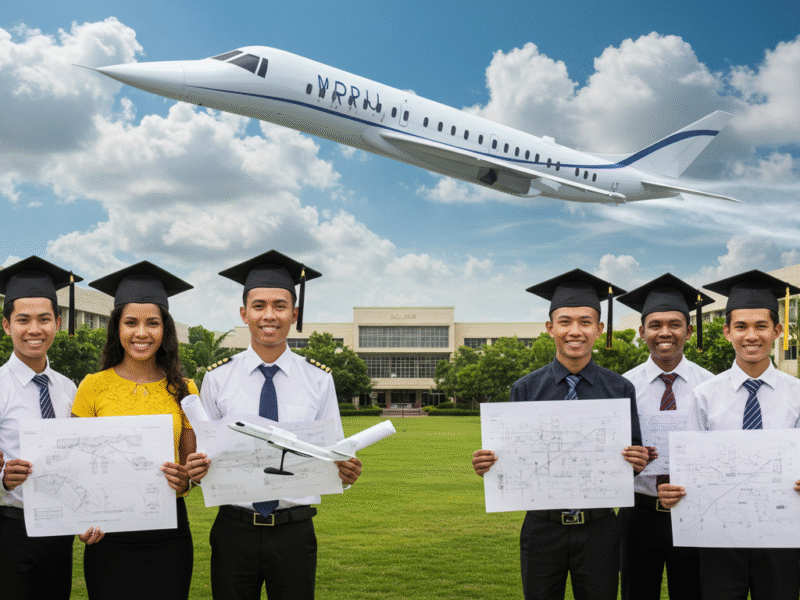Imagine designing the sleek wings of a supersonic jet or engineering drones that revolutionize delivery services – that’s the exhilarating promise of aviation and aeronautical engineering, and pursuing the best courses abroad can launch your career into the stratosphere. If you’re dreaming of a future where you blend science, creativity, and cutting-edge technology to conquer the skies, studying overseas might just be the perfect takeoff point. With global industries booming in aerospace innovation, international programs offer unparalleled exposure to diverse expertise, state-of-the-art facilities, and networks that span continents. In this guide, we’ll dive into everything you need to know about the top aviation engineering programs for international students, from why it’s worth packing your bags to the best universities, admission tips, and career paths that await.
Understanding Aviation and Aeronautical Engineering
Let’s start with the basics – what exactly is aeronautical engineering, and how does it tie into aviation? Aeronautical engineering focuses on the design, development, and maintenance of aircraft, from commercial planes to military jets. It’s all about aerodynamics, propulsion systems, materials science, and ensuring everything flies safely and efficiently. Aviation engineering, on the other hand, often overlaps but can extend to broader aspects like airport operations, air traffic control, and even unmanned aerial vehicles (UAVs). Together, these fields power the multi-billion-dollar aerospace industry, which is projected to grow exponentially with advancements in sustainable aviation and space tourism.
Why does this matter for you? If you’re fascinated by how birds glide or how rockets pierce the atmosphere, these disciplines turn that curiosity into a profession. Courses abroad typically cover core subjects like fluid mechanics, structural analysis, avionics, and flight dynamics. You’ll get hands-on experience through labs, simulations, and even flight testing. But studying internationally adds a layer of global perspective – think collaborating on projects with peers from different cultures, learning about international regulations, and accessing research that’s shaping the future of flight.
The beauty of these programs is their versatility. You could specialize in sustainable aviation fuels to combat climate change or delve into hypersonic travel for faster global connections. With the rise of electric aircraft and autonomous systems, the field is evolving rapidly, making it an exciting time to jump in. And let’s be honest, who wouldn’t want a job where you might get to test-fly prototypes or work on NASA’s next mission?
Read Also:
Why Choose to Study Aviation and Aeronautical Engineering Abroad?
Studying abroad isn’t just about getting a degree – it’s about transforming your worldview and boosting your resume in ways a local program might not. For aviation and aeronautical engineering, going international means tapping into hubs of innovation where the industry thrives. Countries like the USA and UK are home to giants like Boeing and Airbus, offering internships and job opportunities right at your doorstep. Plus, many programs emphasize practical training, so you’ll graduate with real-world skills that employers crave.
One big perk is the diversity of curricula. In Europe, you might focus more on theoretical foundations and research, while US programs often stress entrepreneurship and hands-on projects. This variety lets you pick what aligns with your goals. International students also benefit from multicultural classrooms, where you learn to solve problems from multiple angles – crucial in a field that’s inherently global.
Financially, it can make sense too. While tuition varies, scholarships for aeronautical engineering abroad are plentiful, especially for talented STEM students. And the return on investment? Sky-high. Graduates often land high-paying roles in aerospace firms, with salaries starting around $70,000 in entry-level positions. But beyond money, studying abroad builds resilience, independence, and a network that could lead to collaborations across borders.
Of course, it’s not all smooth flying. Cultural adjustments, visa hurdles, and homesickness are real challenges. But with proper planning, these become growth opportunities. If you’re an aspiring engineer ready to spread your wings, the best aeronautical engineering courses abroad could be your launchpad to a fulfilling career.
Top Countries for Aviation and Aeronautical Engineering Studies
When it comes to the best countries to study aeronautical engineering abroad, a few stand out for their world-class education, industry ties, and welcoming environments for international students. Let’s break it down country by country, highlighting what makes each a top pick.
United States: The Powerhouse of Innovation
The USA tops the list for top aviation engineering programs for international students, thanks to its cutting-edge research and massive aerospace sector. Home to NASA, Boeing, and SpaceX, it’s where dreams of space exploration become reality. Programs here emphasize practical applications, with many universities offering co-op placements where you work in the industry while studying.
Take Massachusetts Institute of Technology (MIT), often ranked as the best college for aerospace engineering. Their aeronautical engineering courses cover everything from aeroelasticity to autonomous systems, with students building actual aircraft prototypes. Tuition might be steep, around $50,000 per year, but scholarships abound. Other standouts include California Institute of Technology (Caltech) and Georgia Institute of Technology, where you can specialize in propulsion or avionics.
What draws international students? The vibrant campus life, diverse communities, and post-study work visas like OPT, which let you gain experience in the US. If you’re into high-tech aviation, the USA’s your destination.
United Kingdom: Tradition Meets Modernity
The UK offers some of the best aeronautical engineering universities in Europe, blending historic prestige with modern facilities. With companies like Rolls-Royce and BAE Systems nearby, internships are a breeze. Programs are shorter – often three years for a bachelor’s – making them efficient for career starters.
Imperial College London leads the pack, with courses in aeronautical engineering that include wind tunnel testing and computational fluid dynamics. University of Bristol and University of Cambridge also shine, offering integrated master’s programs that deepen your expertise. Fees for international students hover around £25,000-£35,000 annually, but the quality is unmatched.
The UK’s appeal? Strong emphasis on research and global rankings, plus English as the primary language eases the transition. If you want a mix of theory and practice in a culturally rich setting, head to the UK.
Canada: Affordable Excellence with a Focus on Sustainability
Canada is rising as a hotspot for affordable aeronautical engineering courses abroad, especially for those interested in green aviation. With lower tuition (around CAD 20,000-40,000) and welcoming immigration policies, it’s ideal for international students.
Top picks include University of Toronto and McGill University, where programs cover aircraft design and space systems. Canada’s aerospace industry, led by Bombardier, provides ample job prospects. Plus, the country’s multicultural vibe makes settling in easy.
Why Canada? Post-graduation work permits up to three years, and a path to permanent residency. If sustainability in aviation excites you, Canada’s programs are leading the charge.
Australia: Cutting-Edge Research Down Under
Australia boasts some of the best aviation courses international, with a focus on Asia-Pacific challenges like long-haul flights. Universities here offer hands-on training in flight simulation and drone technology.
The University of Sydney and Monash University stand out, with aeronautical engineering degrees that include industry placements. Fees are about AUD 40,000-50,000, but scholarships for international students help. Australia’s lifestyle – beaches, wildlife, and safety – is a bonus.
For those eyeing careers in commercial aviation or UAVs, Australia’s programs provide a unique edge.
Germany: Engineering Precision at Low Cost
Germany is a gem for budget-conscious students seeking top aerospace engineering universities abroad. Public universities charge minimal fees (often under €500 per semester), and programs are rigorous.
Technical University of Munich (TU Munich) and RWTH Aachen University excel in aeronautical engineering, with courses in aerodynamics and lightweight materials. Many programs are in English, attracting globals.
Germany’s strength? Strong ties to Airbus and the European Space Agency, plus apprenticeships. If you value precision and affordability, this is your spot.
Other Notable Countries: Netherlands, France, and Japan
Don’t overlook the Netherlands – TU Delft is renowned for its aeronautical programs, focusing on wind energy and space. France offers ISAE-SUPAERO in Toulouse, hub of Airbus. Japan, with University of Tokyo, emphasizes robotics in aviation.
Each country brings something unique, so choose based on your interests and budget.
Best Universities and Their Flagship Courses
Now, let’s zoom in on the cream of the crop – the best aeronautical engineering courses abroad. I’ve curated a list based on global rankings, program quality, and alumni success. Each offers unique strengths, from research opportunities to industry partnerships.
Massachusetts Institute of Technology (MIT), USA
MIT is often hailed as the pinnacle for aerospace engineering universities in the world. Their Bachelor of Science in Aerospace Engineering dives deep into fluid dynamics, propulsion, and controls. You’ll work on projects like building mini-satellites or testing hypersonic vehicles in advanced labs. For master’s, the AeroAstro program allows specializations in autonomy or space systems.
What sets it apart? Access to the MIT Lincoln Laboratory and collaborations with NASA. International students love the vibrant Boston scene and generous funding options. If innovation is your jam, MIT’s where ideas take flight.
Stanford University, USA
Stanford’s Department of Aeronautics and Astronautics ranks among the top, focusing on sustainable aviation and AI in flight. The MS in Aerospace Engineering includes courses on computational aerodynamics and bio-inspired design. Undergrads can join the Stanford Solar Car Project for hands-on fun.
Silicon Valley proximity means internships at Tesla or Lockheed Martin. With a sunny campus and diverse community, it’s perfect for entrepreneurial minds.
California Institute of Technology (Caltech), USA
Caltech’s aerospace program is elite, with small classes and big research. The GALCIT (Graduate Aerospace Laboratories) offers PhDs in aeronautics, emphasizing experimental methods. Courses cover turbulence modeling and spacecraft propulsion.
Known for JPL (Jet Propulsion Lab) ties, it’s space-focused. If you’re research-oriented, Caltech’s intense environment will challenge and reward you.
Imperial College London, UK
Imperial’s Aeronautical Engineering MEng is a four-year integrated master’s, covering design, analysis, and testing. You’ll use wind tunnels and flight simulators, with options for study abroad.
Central London location means easy access to industry events. It’s great for those wanting a balanced academic and social life.
University of Cambridge, UK
Cambridge’s Engineering Tripos includes aeronautical specializations in later years, with projects on UAVs and composites. The historic setting inspires, and alumni networks are legendary.
If theory and prestige appeal, Cambridge delivers.
TU Delft, Netherlands
TU Delft’s BSc in Aerospace Engineering is hands-on, with design-build-fly competitions. Master’s in Aerospace Structures focus on sustainable materials.
Affordable and innovative, it’s ideal for eco-conscious engineers.
Politecnico di Milano, Italy
This Italian gem offers a MSc in Aeronautical Engineering, blending design and management. Low fees and Milan’s fashion vibe add flair.
For those wanting European culture with strong engineering, it’s a winner.
University of Toronto, Canada
U of T’s Institute for Aerospace Studies offers MASc programs in flight dynamics and robotics. Research in hypersonics is cutting-edge.
Toronto’s diversity and job market make it appealing.
Purdue University, USA
Purdue’s School of Aeronautics and Astronautics is astronaut alumni central. Courses include aircraft design and propulsion.
Affordable for a top program, with Big Ten sports for fun.
Embry-Riddle Aeronautical University, USA
Specialized in aviation, their BS in Aeronautical Science combines engineering and piloting. Campuses in Florida and Arizona offer flight training.
If you want to fly while studying, this is it.
And that’s just a sampling – there are dozens more like Georgia Tech, ETH Zurich, and University of Sydney. Each program tailors to specific interests, so research what fits your passion.
Admission Requirements for International Students
Getting into these top programs isn’t easy, but with preparation, it’s achievable. General admission requirements for aeronautical engineering courses abroad include a strong high school background in math, physics, and chemistry. For bachelor’s, you’ll need good grades – think 85% or higher – and standardized tests.
In the USA, SAT or ACT scores are common, with minima around 1400 for SAT. UK universities require A-levels or IB, often with A* in math and physics. English proficiency is key – IELTS 6.5+ or TOEFL 90+ for non-natives.
For master’s, a relevant bachelor’s degree with GPA 3.0+, GRE scores (sometimes), and letters of recommendation. Portfolios of projects or research experience boost your app.
Visas? Student visas require proof of funds, acceptance letters, and health insurance. Start early – applications open a year in advance. Tips: Highlight extracurriculars like robotics clubs or flight simulations to stand out.
Scholarships and Funding Options
Money shouldn’t ground your dreams. Scholarships for international students in aeronautical engineering abroad are plentiful. In the USA, Fulbright or university-specific aids like MIT’s need-based grants cover tuition.
UK offers Chevening for leaders, while Canada’s Vanier scholarships target STEM. Germany has DAAD for low-cost studies. Look for industry-sponsored ones from Boeing or Airbus.
Apply early, with strong essays showing your passion. Part-time jobs or assistantships can supplement.
Career Prospects After Graduation
The sky’s the limit for career prospects after an aeronautical engineering degree abroad. Graduates enter roles like aerospace engineer, avionics specialist, or flight test engineer. Salaries average $80,000-$120,000, higher in the US.
Industries? Airlines, defense, space agencies, or startups in drones. International degrees open global doors – work in Europe with a US qualification. Advancement to management or research is common.
Challenges? ITAR restrictions for non-US citizens in defense, but commercial aviation is open. With experience, you could design sustainable jets or lead space missions.
Student Life and Experiences Abroad
Studying abroad is more than classes – it’s adventures. In the US, join flying clubs or attend air shows. UK offers pub culture and travel to Europe. Make friends from everywhere, building a global network.
Challenges like culture shock? Universities have support services. Embrace it – it builds character.
Conclusion
Pursuing the best aviation and aeronautical engineering courses abroad is an investment in a soaring future. From MIT’s innovations to TU Delft’s sustainability focus, options abound. With preparation, you can navigate admissions, funding, and careers successfully. Ready to take off?
For more on university rankings, visit QS World University Rankings.
Explore scholarships at IDP Scholarships for Aerospace Engineering.











